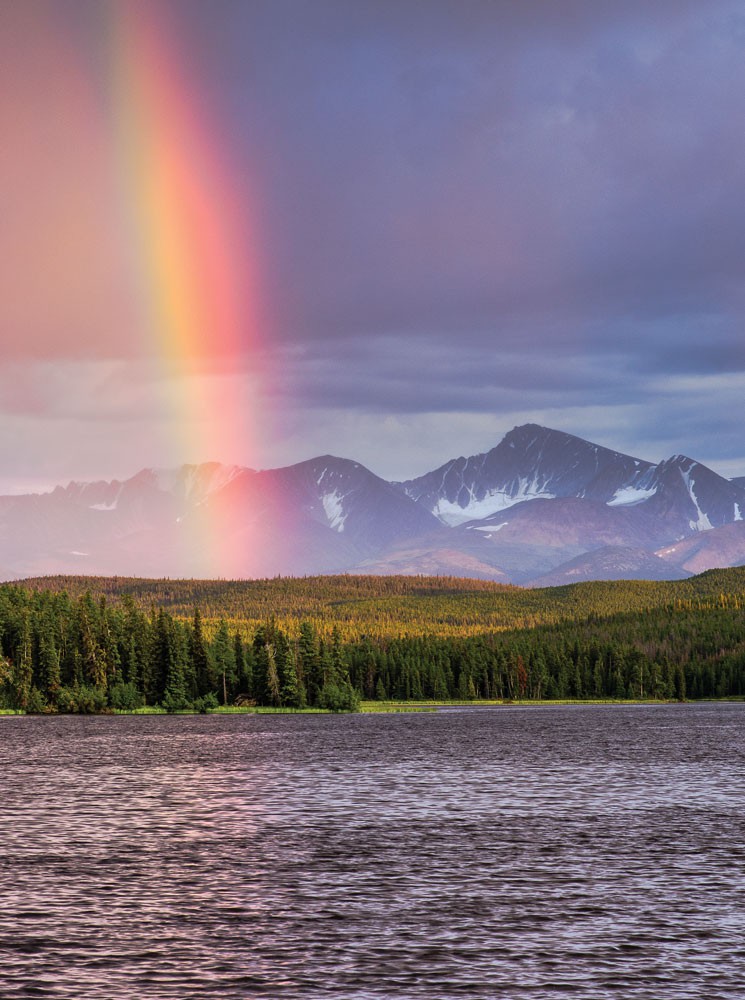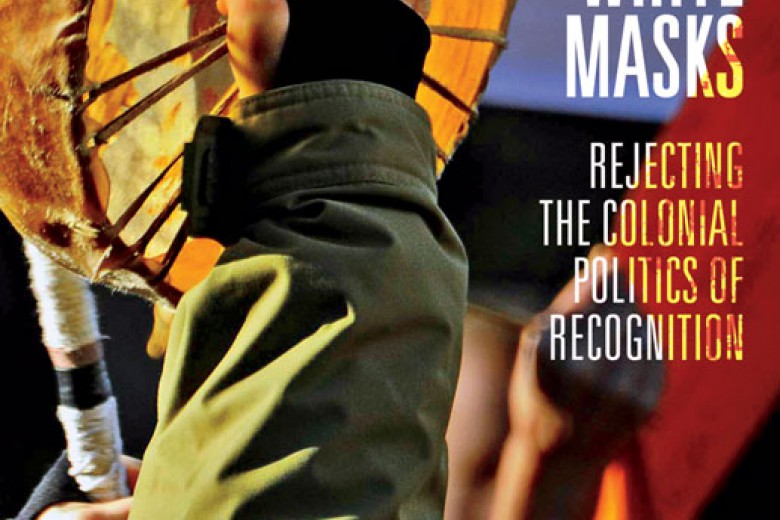
Fish Lake, or Teztan Biny in the Tsilhqot’in language, is the site of a gold and copper mine proposal now twice rejected. The lake lies in the heart of Indigenous Tsilhqot’in territory, between the communities of Xeni Gwet’in (Nemiah Band) and Yunesit’in (Stone Band) in B.C.’s central interior. The latest mine proposal for the area, the second by Vancouver-based Taseko Mines Limited in recent years, was called the New Prosperity mine project and included a 125-kilometre transmission line corridor.
During the community hearings for the mine proposal last summer in Xeni Gwet’in, councillor Loretta Williams declared: “We will not even entertain the idea of losing the area. We cannot lose this area because of its spiritual significance.” The celebrated jumping rainbow trout of Fish Lake are part of a larger ecosystem that has supported the Tsilhqot’in people for thousands of years.
Throughout the hearings, the Tsilhqot’in community made a clear case for rejecting the Taseko Mines proposal. Elders, adults, and youth emphasized the significance of Tsilhqot’in territory to their livelihoods.
For the land
Shania Cook, a youth in Xeni Gwet’in, said: “I love my land. I like practising the traditional activities that I learn. I like sweat lodges. It brings me closer to my ancestors. I can pray for anything and anyone. When I am in the sweat lodge, I pray for the Prosperity project to stop and that our land will be free again, free from destruction … This is the home of our ancestors … This is how we stay connected to them and the land.”

On a bustling Friday before Christmas in downtown Vancouver last December, nearly 200 Tsilhqot’in people and their allies assembled to march to Taseko Mines’ head office on West Georgia Street. The invitation to the event stressed that the Tsilhqot’in have spent three decades defending Fish Lake from the threat of this mine.
The downtown dance ceremony blended hip hop with traditional Tsilhqot’in singing. The name Tsilhqot’in means “people of the river,” and dancers in the ceremony wore blue blankets to represent fresh water. Two months after the ceremony, on February 27, 2014, Taseko’s New Prosperity mine was rejected by a federally appointed panel of the Canadian Environmental Assessment Agency.
A celebrated fishing destination, Fish Lake is surrounded by unlogged forests and framed by Mount Ts’yl?os. The Fish Lake watershed has been left largely unaffected by industrial development, a rarity given Canada’s unbridled appetite for natural resources. In B.C. alone, the government’s 2012 mining strategy, implemented by Liberal Premier Christy Clark, called for eight new mines in B.C. by 2015.
The fight to save Fish Lake is not a new one, nor are the racialized regional politics of resource extraction unique. To the east, in the city of Williams Lake, a shopping mall was built on an Indigenous burial ground following land disputes that date back to the 1860s and the famous words of Chief William in 1879: “The white men have taken all the land and all the fish. A vast country was ours. It is all gone.” Amid racial tensions and land disputes that run deep in the central interior, Ts’yl?os Provincial Park was established in 1994 in collaboration with Chief Roger William of the Xeni Gwet’in Nation. (The park’s boundaries are just shy of Fish Lake.)

The honour of the Crown
Unlike much of the rest of Canada, the numbered treaty process did not extend to most of B.C. Consequently, the relationship between Tsilhqot’in and the settler state is contested in a different way than in places where historic treaty relationships exist. (The Tsilhqot’in have a land title case currently awaiting a decision in the Supreme Court of Canada.)
Though the specific mine proposal dates back to the 1990s, mineral rights were legally alienated from the Tsilhqot’in well before then through the province’s mineral staking system that has yet to allow for Indigenous consent at the mineral staking stage. A critical dimension of the current conflict over Fish Lake is that the mining company’s claim to the copper and gold is based on archaic principles enshrined in B.C.’s Mineral Tenure Act.
As one would guess, B.C.’s model of mineral staking smooths the process of Indigenous dispossession for industrial interests. Two of the six Tsilhqot’in chiefs, Joe Alphonse and Roger William, have raised criticisms of the province’s Mineral Tenure Act in the context of the New Prosperity rejection. They note that even a right-wing Canadian think-tank, the Fraser Institute, recognizes that mineral staking and the Crown ownership of minerals leads to conflicts over Indigenous territory.
The project’s environmental assessment hearings – a state-sanctioned mechanism – clearly outlined and recorded the impact the mine would have on Tsilhqot’in fishing and hunting grounds. In addition to environmental impacts, the Taseko mine was also rejected based on the impacts it would have on cultural transmission and ways of life.
In early March, speaking to the Prospectors and Developers Association of Canada in Toronto, Prime Minister Stephen Harper referred to the second panel report that led to the mine’s rejection as “damning.” Despite his infamy for the omnibus budget bills that incited the Idle No More movement, Harper admitted at the Toronto meeting that “local Aboriginal groups … do not approve” of the Taseko mine.
Harper’s statements don’t surprise Ramsey Hart of MiningWatch Canada, however, who says: “Harper’s response was in line with the findings of both review panels, the previous statements he and Jim Prentice made on the Prosperity project, and the most recent cabinet decision on New Prosperity.”
Hart also confirms the results of the federal environmental assessment. “It’s a matter of fact that the Indigenous communities that would be adversely impacted by the project are steadfastly opposed to it. Why Harper chose to acknowledge and respect their opposition when he railroads others is a bit of a mystery but likely has to do with their legal status with proven Aboriginal rights to the mine area and the damning environmental assessment report.”
Meanwhile, Taseko Mines Limited argues they are the ones who have been treated unfairly. Fighting the mine’s rejection in the courts, Taseko has submitted two judicial reviews: one of the federal independent panel report and a second of the mine rejection itself.
But regardless of these, the company’s tactics, steeped in the logics of settler-colonial capital accumulation, have been successfully resisted.
In a press release from March 2014, Chief Joe Alphonse, tribal chair for the Tsilhqot’in National Government, said, “The latest legal action is a desperate attempt by a desperate company to distract everyone from the facts.”
“We are equally disappointed that the B.C. government, and in particular Mines Minister Bennett, continue to talk and act as if this project has been wrongly rejected and still has a chance of proceeding,” said Chief Russell Myers Ross of the Yunesit’in government in the same press release. “We know from the elections records that the Liberal government and Mr. Bennett have received political funding from [Taseko]. We also know that under Mr. Bennett in 2010 the province became the only regulatory authority to approve the mine and claim that it posed no problems of major concern. Neither fact justifies the government continuing to blindly support this project, providing the company’s investors with false hope, and generating more stress for our communities. The conduct of the Province on this file calls into question the honour of the Crown, considering the B.C. environmental assessment amendment process is incomplete.”
Taseko’s promise of jobs in the mining industry seeks to overpower the value of traditional lifeways and sacred lands. The company’s claim to the copper and gold, based on Crown ownership and the alienation of mineral rights, seeks to erase Indigenous title. But the Tsilhqot’in National Government has remained firm in its rejection of jobs in private industry in exchange for desolation of land and territory. The second rejection of the New Prosperity proposal this year is a victory for the Tsilhqot’in resistance, a resistance that seeks to maintain Teztan Biny – Fish Lake – for future generations.






